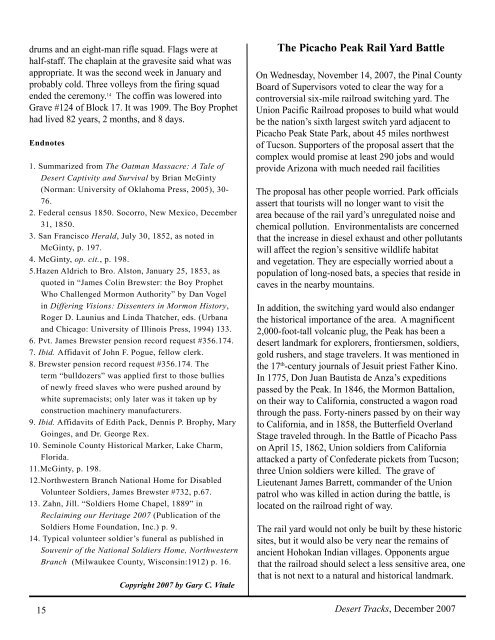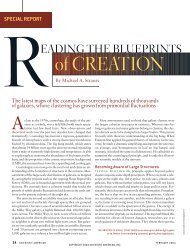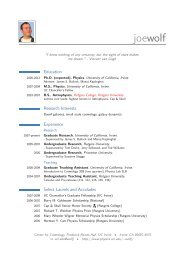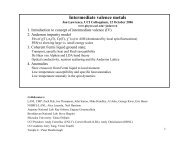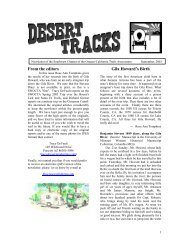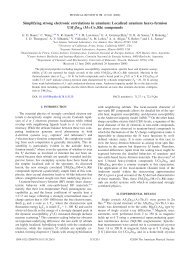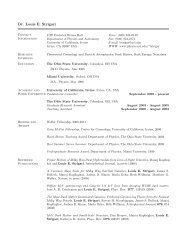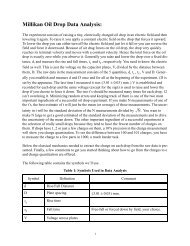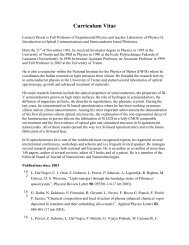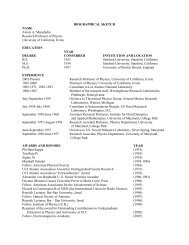Work on the Apache Pass Trail - Southern Trails Chapter
Work on the Apache Pass Trail - Southern Trails Chapter
Work on the Apache Pass Trail - Southern Trails Chapter
You also want an ePaper? Increase the reach of your titles
YUMPU automatically turns print PDFs into web optimized ePapers that Google loves.
drums and an eight-man rifle squad. Flags were at<br />
half-staff. The chaplain at <strong>the</strong> gravesite said what was<br />
appropriate. It was <strong>the</strong> sec<strong>on</strong>d week in January and<br />
probably cold. Three volleys from <strong>the</strong> firing squad<br />
ended <strong>the</strong> cerem<strong>on</strong>y. 14 The coffin was lowered into<br />
Grave #124 of Block 17. It was 1909. The Boy Prophet<br />
had lived 82 years, 2 m<strong>on</strong>ths, and 8 days.<br />
Endnotes<br />
1. Summarized from The Oatman Massacre: A Tale of<br />
Desert Captivity and Survival by Brian McGinty<br />
(Norman: University of Oklahoma Press, 2005), 30-<br />
76.<br />
2. Federal census 1850. Socorro, New Mexico, December<br />
31, 1850.<br />
3. San Francisco Herald, July 30, 1852, as noted in<br />
McGinty, p. 197.<br />
4. McGinty, op. cit., p. 198.<br />
5.Hazen Aldrich to Bro. Alst<strong>on</strong>, January 25, 1853, as<br />
quoted in “James Colin Brewster: <strong>the</strong> Boy Prophet<br />
Who Challenged Morm<strong>on</strong> Authority” by Dan Vogel<br />
in Differing Visi<strong>on</strong>s: Dissenters in Morm<strong>on</strong> History,<br />
Roger D. Launius and Linda Thatcher, eds. (Urbana<br />
and Chicago: University of Illinois Press, 1994) 133.<br />
6. Pvt. James Brewster pensi<strong>on</strong> record request #356.174.<br />
7. Ibid. Affidavit of John F. Pogue, fellow clerk.<br />
8. Brewster pensi<strong>on</strong> record request #356.174. The<br />
term “bulldozers” was applied first to those bullies<br />
of newly freed slaves who were pushed around by<br />
white supremacists; <strong>on</strong>ly later was it taken up by<br />
c<strong>on</strong>structi<strong>on</strong> machinery manufacturers.<br />
9. Ibid. Affidavits of Edith Pack, Dennis P. Brophy, Mary<br />
Goinges, and Dr. George Rex.<br />
10. Seminole County Historical Marker, Lake Charm,<br />
Florida.<br />
11.McGinty, p. 198.<br />
12.Northwestern Branch Nati<strong>on</strong>al Home for Disabled<br />
Volunteer Soldiers, James Brewster #732, p.67.<br />
13. Zahn, Jill. “Soldiers Home Chapel, 1889” in<br />
Reclaiming our Heritage 2007 (Publicati<strong>on</strong> of <strong>the</strong><br />
Soldiers Home Foundati<strong>on</strong>, Inc.) p. 9.<br />
14. Typical volunteer soldier’s funeral as published in<br />
Souvenir of <strong>the</strong> Nati<strong>on</strong>al Soldiers Home, Northwestern<br />
Branch (Milwaukee County, Wisc<strong>on</strong>sin:1912) p. 16.<br />
15<br />
Copyright 2007 by Gary C. Vitale<br />
The Picacho Peak Rail Yard Battle<br />
On Wednesday, November 14, 2007, <strong>the</strong> Pinal County<br />
Board of Supervisors voted to clear <strong>the</strong> way for a<br />
c<strong>on</strong>troversial six-mile railroad switching yard. The<br />
Uni<strong>on</strong> Pacific Railroad proposes to build what would<br />
be <strong>the</strong> nati<strong>on</strong>’s sixth largest switch yard adjacent to<br />
Picacho Peak State Park, about 45 miles northwest<br />
of Tucs<strong>on</strong>. Supporters of <strong>the</strong> proposal assert that <strong>the</strong><br />
complex would promise at least 290 jobs and would<br />
provide Ariz<strong>on</strong>a with much needed rail facilities<br />
The proposal has o<strong>the</strong>r people worried. Park officials<br />
assert that tourists will no l<strong>on</strong>ger want to visit <strong>the</strong><br />
area because of <strong>the</strong> rail yard’s unregulated noise and<br />
chemical polluti<strong>on</strong>. Envir<strong>on</strong>mentalists are c<strong>on</strong>cerned<br />
that <strong>the</strong> increase in diesel exhaust and o<strong>the</strong>r pollutants<br />
will affect <strong>the</strong> regi<strong>on</strong>’s sensitive wildlife habitat<br />
and vegetati<strong>on</strong>. They are especially worried about a<br />
populati<strong>on</strong> of l<strong>on</strong>g-nosed bats, a species that reside in<br />
caves in <strong>the</strong> nearby mountains.<br />
In additi<strong>on</strong>, <strong>the</strong> switching yard would also endanger<br />
<strong>the</strong> historical importance of <strong>the</strong> area. A magnificent<br />
2,000-foot-tall volcanic plug, <strong>the</strong> Peak has been a<br />
desert landmark for explorers, fr<strong>on</strong>tiersmen, soldiers,<br />
gold rushers, and stage travelers. It was menti<strong>on</strong>ed in<br />
<strong>the</strong> 17 th -century journals of Jesuit priest Fa<strong>the</strong>r Kino.<br />
In 1775, D<strong>on</strong> Juan Bautista de Anza’s expediti<strong>on</strong>s<br />
passed by <strong>the</strong> Peak. In 1846, <strong>the</strong> Morm<strong>on</strong> Battali<strong>on</strong>,<br />
<strong>on</strong> <strong>the</strong>ir way to California, c<strong>on</strong>structed a wag<strong>on</strong> road<br />
through <strong>the</strong> pass. Forty-niners passed by <strong>on</strong> <strong>the</strong>ir way<br />
to California, and in 1858, <strong>the</strong> Butterfield Overland<br />
Stage traveled through. In <strong>the</strong> Battle of Picacho <strong>Pass</strong><br />
<strong>on</strong> April 15, 1862, Uni<strong>on</strong> soldiers from California<br />
attacked a party of C<strong>on</strong>federate pickets from Tucs<strong>on</strong>;<br />
three Uni<strong>on</strong> soldiers were killed. The grave of<br />
Lieutenant James Barrett, commander of <strong>the</strong> Uni<strong>on</strong><br />
patrol who was killed in acti<strong>on</strong> during <strong>the</strong> battle, is<br />
located <strong>on</strong> <strong>the</strong> railroad right of way.<br />
The rail yard would not <strong>on</strong>ly be built by <strong>the</strong>se historic<br />
sites, but it would also be very near <strong>the</strong> remains of<br />
ancient Hohokan Indian villages. Opp<strong>on</strong>ents argue<br />
that <strong>the</strong> railroad should select a less sensitive area, <strong>on</strong>e<br />
that is not next to a natural and historical landmark.<br />
Desert Tracks, December 2007


